A self-reliant agricultural sector is the largest source of livelihood in India and hence well-being of farmers, productivity of farming, and sustainable agricultural practices play an important role in the growth of a nation. To make farming in India less risky and profitable, not only modernization of agriculture is important but also building a safety net for the farmers is critical so that they have less dependency on rainfall for irrigation.
As per the 2011 census, India has 26.31 core agricultural workers (11.88 crore cultivators and 14.43 crore agricultural laborers). The government is committed to their welfare and has launched various schemes to help farmers adopt smart farming by extending income support and improving access to information so that farmers can increase their land productivity which leads to high income.
With the concerted efforts of the government, not only agricultural production has increased exponentially during the last few years but also farmers of India have been empowered to become agricultural entrepreneurs due to the farmer-friendly agri-policies that have been launched in the last decade.
To elaborate on this, there has been a 4-fold rise in the budget allocation for agriculture that has increased from 25,000 crore in 2014 to 1.25 lakh crore in the 2023 budget which reflects the welfare of farmers as one of the key focus areas for the government. Additionally, in 2022-23, the agricultural sector received institutional credit amounting to Rs 18.5 lakh crore.
The key schemes launched by the government to empower the farmers are:
Pradhan Mantri Fasal Bima Yojana
Launched in 2016, this was a government sponsored crop insurance scheme that supported sustainable production in agricultural sector by:
- Providing financial support to farmers suffering crop loss/damage arising out of unforeseen events
- Stabilizing the income of farmers to ensure their continuance in farming
- Encouraging farmers to adopt innovative and modern agricultural practices
- Ensuring flow of credit to the agriculture sector; which will contribute to food security, crop diversification and enhancing growth and competitiveness of agriculture sector besides protecting farmers from production risks.
As on 2023, over 1.2 lakh crore have been settled in claims under Pradhan Mantri Fasal Bima Yojana.
Pradhan Mantri Kisan Samman Nidhi (PM-KISAN) Scheme
Launched in 2019, this scheme aims to provide income support to all landholder farmer families across the country with cultivable land, subject to specific exclusions. Under the Scheme, an amount of Rs 6000 per year is released in three instalments of Rs 2000 each directly into the beneficiaries’ bank accounts. This annual income enabled small farmers to purchase better quality inputs, improve their land productivity and increase their income.
As on Dec 2023, over 2.62 lakh crore of funds have been distributed to more than 11.8 crore farmer families. During Covid Pandemic, to provide security to the farmers, Rs 1.75 lakh crores were distributed in multiple instalments to support these needy farmers.
Pradhan Mantri Krishi Sinchai Yojana (PMKSY)
This scheme was launched in 2015 with the objective to provide water to every field. In this scheme, government provide end-to end solutions in irrigation supply chain such as water sources, distribution network & farm level applications. The farmers can contact District Agriculture/Horticulture officer for obtaining subsidy on drip/sprinkler irrigation technique and priority is given to projects which are close to completion so that farmers can get immediate benefit.
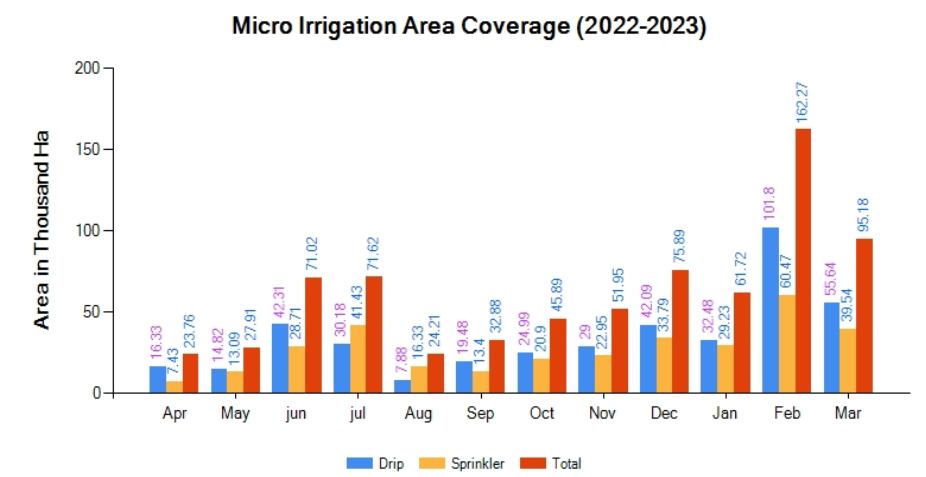
Over Rs 93,068 crore have been allocated by the government for PM Krishi Sinchayee Yojana for 2021-2026 and over 16 lakh hectare area has been covered under micro-irrigation as on March, 2023.
Pradhan Mantri Kisan Samruddhi Kendra (PMKSK)
The Pradhan Mantri Kisan Samruddhi Kendra (PMKSK) is a government initiative that is transforming the agricultural sector in India. More than 1 lakh fertilizer shops have been converted into PMKSKs, and the remaining 1.8 lakh shops are expected to be converted by the end of 2023.
PMKSKs are providing farmers with the tools and information they need to improve their yields and incomes. They are providing quality agri-inputs like fertilizers, seeds, and pesticides at reasonable prices under one roof. They are also providing soil/seed/fertilizer testing facilities or connecting farmers to those facilities.
PMKSKs ensure the availability of small and large farm implements through sale or Custom Hiring centers. They create awareness among farmers regarding good agricultural practices. They provide information regarding various government schemes related to farmers. PMKSKs ensure regular capacity building of retailers at block/district level outlets.
According to a study by the Indian Council of Agricultural Research, PMKSKs have had a positive impact on farmers’ yields and incomes. The study found that farmers who used PMKSKs saw an average increase in their yields of 10%. They also saw an average increase in their incomes of 15%.
The study also found that PMKSKs have helped to improve farmers’ access to credit. Farmers who used PMKSKs were more likely to have access to credit, and they were also more likely to use credit to invest in their farms.
Pradhan Mantri Kisan Urja Suraksha evam Utthan Mahabhiyaan (KUSUM)
This was aimed at furthering the production of solar power in India and promote income generation of farmers through installation of solar panels on barren land. In this scheme, Tube wells and existing pumps of the government will be converted to run on solar power. To enable this, the farmers will get a subsidy of 60% on solar pumps which will be deposited into the accounts of farmers, 30% of the cost will be given as loan and only 10% will have to be borne by the farmers.
The approved scheme is comprised of three components:
- Component-A: Addition of 10,000 MW of solar capacity through the installation of small solar power plants of capacity up to 2 MW.
- Component-B: Installation of 20 lakh standalone solar-powered agricultural pumps
- Component-C: Solarization of 15 lakh existing Grid-connected Agriculture Pumps
In the first phase, the government will distribute 1.75 million off-grid agricultural solar pumps and 10000 Mega Watts Solar plants will be put up on lands that are barren. The state electricity distribution companies, also called, DISCOMS will buy this additional solar power produced by the farmers on barren lands. DISCOMS will get sops to buy this electricity. This scheme has been termed as one of the largest initiatives of the world to provide clean energy to more than 35 lakhs farmers by solarizing their agriculture pump under components B and C.
Kisan Rail Scheme
To ensure smooth transportation of agricultural produce, Kisan Rail Scheme facilitates the operation of special trains for the movement of perishable agricultural products such as fruits, vegetables, meat, poultry, fishery and dairy products from production or surplus regions to consumption or deficient regions, and speedy movement to ensure minimum damage during transit. With a 50% freight subsidy, it’s broadening market access for fruits and vegetables.
These trains help to increase the income in farm sector by connecting production centers to markets and consumption centers. As on 2023, Indian Railways has operated nearly 2300 kisan rail services on 167 routes are operational and that have transported around 7.9 lakh tonne of perishables from one place to another.
National Agriculture Market (e-NAM)
National Agriculture Market has been designed to create a national network of physical mandis which can be accessed online. It seeks to leverage the physical infrastructure of the mandis through an online trading portal, enabling buyers situated even outside the State to participate in trading at the local level.
Thus, it is linking the agricultural markets throughout the country has not only helped farmers to get better prices for their yields but has also reduced price distortions that hampered consumer interests. E-NAM has been a very successful initiative and since its launch in 2016, 1389 mandis have been integrated along with onboarding of 3,510 FPO’s; 1.77 crore farmers & 2.5 lakh traders have registered and Rs. 1.9 lakh crore trade value recorded as on Dec, 2023.
Agricultural Infrastructure Fund
Launched in 2020, this scheme is intended to provide a medium – long term debt financing facility for investment in viable projects for post-harvest management Infrastructure and community farming assets through interest subvention and financial support. The farmers are being provided basic facilities like godowns, custom hiring centres, primary processing units, sorting and grading units, and cold storages for them. The government has allocated over Rs 1 lakh crore under the Agriculture Infrastructure Fund for the welfare of farmers.
Additionally, government is helping farmers to transition towards smart farming within which useful scientific information and latest innovation in agriculture are being made available to them.
The programs undertaken to encourage farmers adopt these measures are:
Natural Farming
Natural Farming is not only beneficial to the farmers but also helps in ensuring better soil biology, improved agrobiodiversity and a more judicious use of water with lesser carbon and nitrogen footprints The government has realised its potential and is heavily promoting it across country. In fact, in states such as Uttarakhand, Uttar Pradesh, Bihar, Jharkhand and West Bengal, the government has made provisions to isolate 5 km on either banks of Ganga for natural farming.
The government has constituted a committee from the Indian Council of Agricultural Research (ICAR) to include materials related to natural farming in undergraduate and postgraduate teaching courses.
Soil Health Card
A soil health card is used to assess the current status of soil health and, when used over time, to determine changes in soil health that are affected by land management. A Soil Health Card will be given to farmers once in 3 years and it will not only display soil health indicators but also indicate fertilizer recommendations and soil amendment required for the farm so that farmer can get high yields.
The soil card will give the farmers a proper idea of which nutrients their soil is lacking. And hence, which crops they should invest in. they will also tell which fertilizers they need. So, ultimately, the crop yield will see a rise. As on 2023, 23.58 crore soil health cards have been distributed to farmers across various states of India.
Fertiliser Subsidy
Fertilisers are used by farmers to increase the growth and productiveness of their crops. In the Fertiliser Subsidy scheme, the government pays a subsidy to fertiliser producer and allows farmers to buy fertilisers at below-market rates. The fertilizer subsidy has been increased by 140% to protect farmers from global price surge and an estimated expenditure of Rs 22,303 is allocated to ensure farmers access subsidized and affordable fertilizers.
Enhancing Returns through Revised Minimum Support Price
Under PM Modi’s leadership, prioritizing farmers’ interests has resulted in a notable rise in Minimum Support Prices (MSPs), fostering prosperity for our Annadatas over the past decade.
The significant rise of 39.5% in farmers selling their food grains to the Government at fair prices underscores a steadfast commitment to bolstering agriculture.
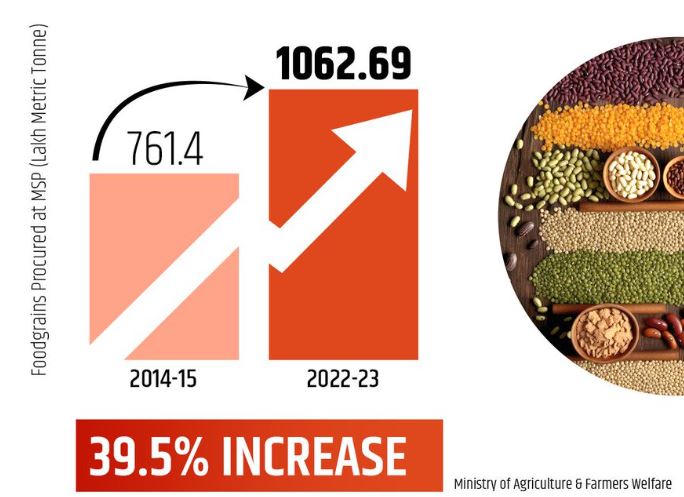
The substantial increase in expenditure at Minimum Support Price (MSP) values by 115% signifies a substantial investment in the backbone of our nation’s agricultural sector.
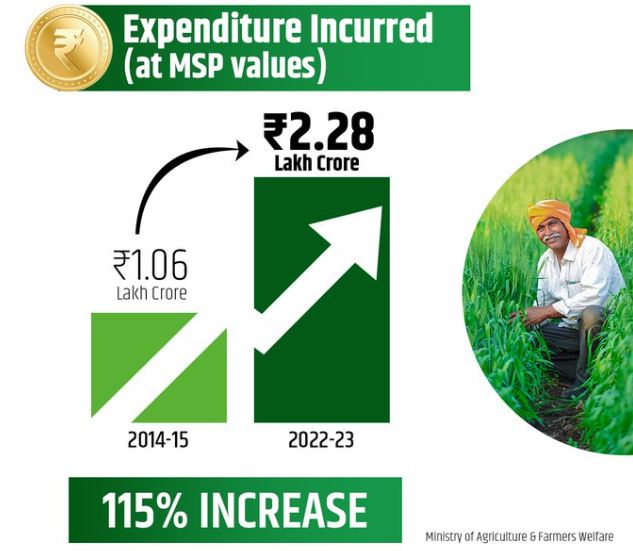
It reflects a proactive approach aimed at ensuring fair compensation for farmers and enhancing their economic stability, thus fostering a resilient agricultural ecosystem for sustained growth and prosperity.
The government has consistently raised the minimum support prices for Kharif, Rabi, and other commercial crops. In the year 2013-14, the Minimum Support Price (MSP) for Paddy minimum support price for paddy was Rs 1,310 per quintal. This has increased by 67% to an MSP of Rs 2,183 per quintal for paddy in 2023-24.
Likewise, during 2013-14, the Minimum Support Price (MSP) for wheat stood at Rs 1,350 per quintal. This has seen a significant rise, reaching Rs 2,275 per quintal for wheat in 2023-24, marking a 68.5% increase. In the period between 2013-14 and 2023-24, the Minimum Support Price (MSP) for Masoor Dal has surged by 118%, enhancing its profitability for farmers significantly. The price has risen from Rs 2950 to Rs 6425.
In a move aimed at empowering coconut growers, the Minimum Support Price (MSP) for Copra for the 2024 Season has been approved at Rs 11,160 per quintal for Milling copra, marking a substantial 113% increase since 2014-15. Additionally, there has been a significant 118% rise in the MSP of ball copra.
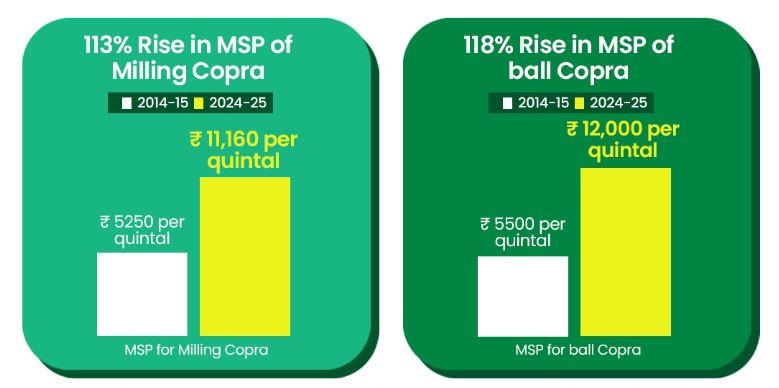
Also, as on May 2023, the government has approved Rs 1.8 lakh crore subsidy for the ongoing monsoon or kharif season. During the Rabi marketing season in 2021-22, 433.44 lakh metric tonnes of wheat was procured by the government at MSP, which is the highest-ever procurement. The cumulative figures show that 49.19 lakh wheat-producing farmers got Rs 85,604.40 crore in MSP during the season and that payment has been made directly into their bank accounts.
Empowering the Turmeric Farmers
The notification of the establishment of the National Turmeric Board marks a significant stride towards enhancing the turmeric industry. With a targeted goal of elevating turmeric exports to 1 billion by 2030, the initiative focuses on multiple fronts. It aims to raise awareness and consumption of turmeric while simultaneously exploring new international markets to bolster exports.
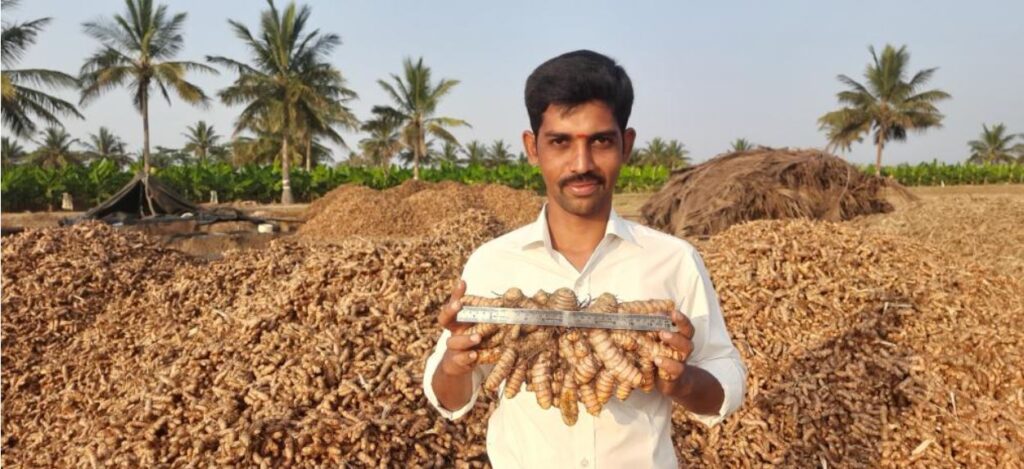
Additionally, the promotion of research and development endeavors to harness our traditional knowledge for innovating new turmeric products stands as a cornerstone of this effort. Ultimately, the establishment of the National Turmeric Board is a pivotal step towards empowering turmeric farmers and advancing the industry’s growth trajectory.
Revolutionizing Grain Storage
The Modi Government is reaping success in its efforts to support our Annadatas. Recently, approval was granted for the world’s largest grain storage plan within the cooperative sector. This initiative aims to alleviate the shortage of agricultural storage infrastructure, curtail food grain wastage at the local level, and minimize the costs associated with transportation.
Additionally, it is poised to deter distress sales of crops, enabling farmers to secure better prices for their produce. This strategic move underscores the government’s commitment to enhancing the welfare of farmers and fortifying the agricultural landscape.
Impact of Government Schemes on Foodgrain Production
There has been a paradigm shift in Indian agriculture due to the programs and schemes of the government that has led to a steady increase in farm yields. As per RBI data, production of food grains is estimated to be around 316 million tonnes, while the production of sugarcane is estimated at 414 million tonnes, the highest ever as in February, 2022.
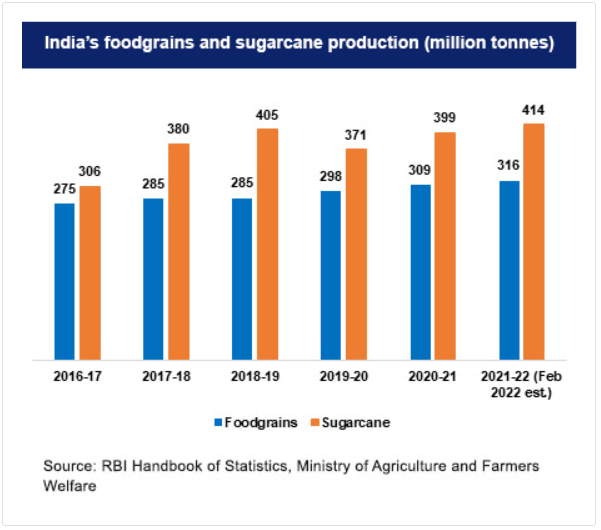
Impact of Government Schemes on Export
The Indian farmers are not producing only for self-consumption or sale in the domestic market but they seek to export their products and feed the world. With this increased production, the export of agriculture produce has also increased and reached almost 49.6 billion dollars in 2021-2022 from 41.3 billion dollars in 2020-2021 as per the data from Ministry of Commerce & Industry.
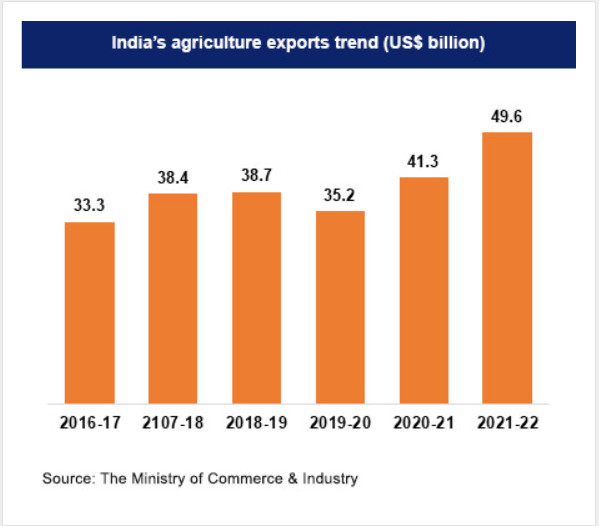
India is one of the largest agricultural product exporters in the world. Even amidst the challenges of the Covid-19 pandemic, India has emerged as a major supplier of food grains to the countries in need.
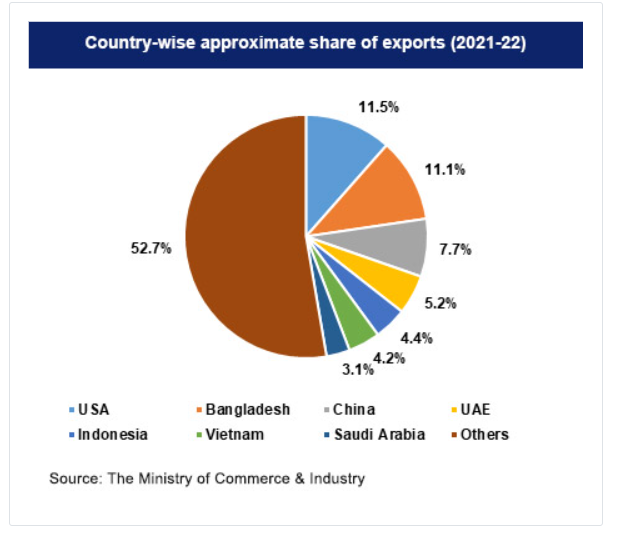
As per the latest Economic Survey 2022-23, India’s agriculture sector has been witnessing robust growth with an average annual growth rate of 4.6 % over the last six years. This has enabled the agriculture and allied activities sector to contribute significantly towards the country’s overall growth, development, and food security. Over the past nine years, more than 3000 agricultural startups have emerged, contributing to a landscape that was previously devoid of such innovation.
India is becoming self-reliant in the agriculture sector and the near future apart from being self-sufficient in food production, India will play a major role to meet the food requirements of a larger part of the world with the help of empowered Indian farmers.
References
https://krishijagran.com/blog/top-agriculture-schemes-launched-by-prime-minister-narendra-modi/








